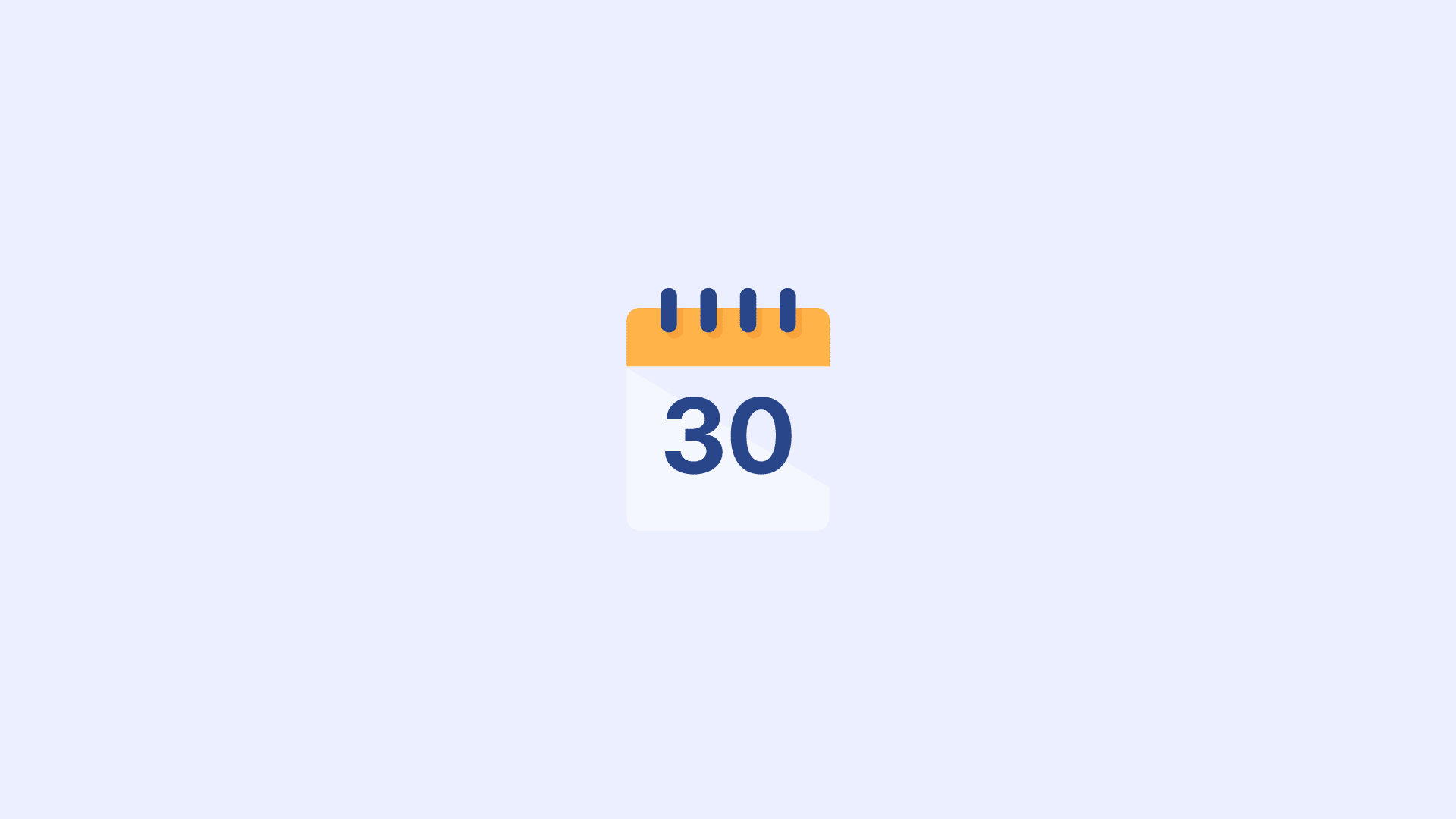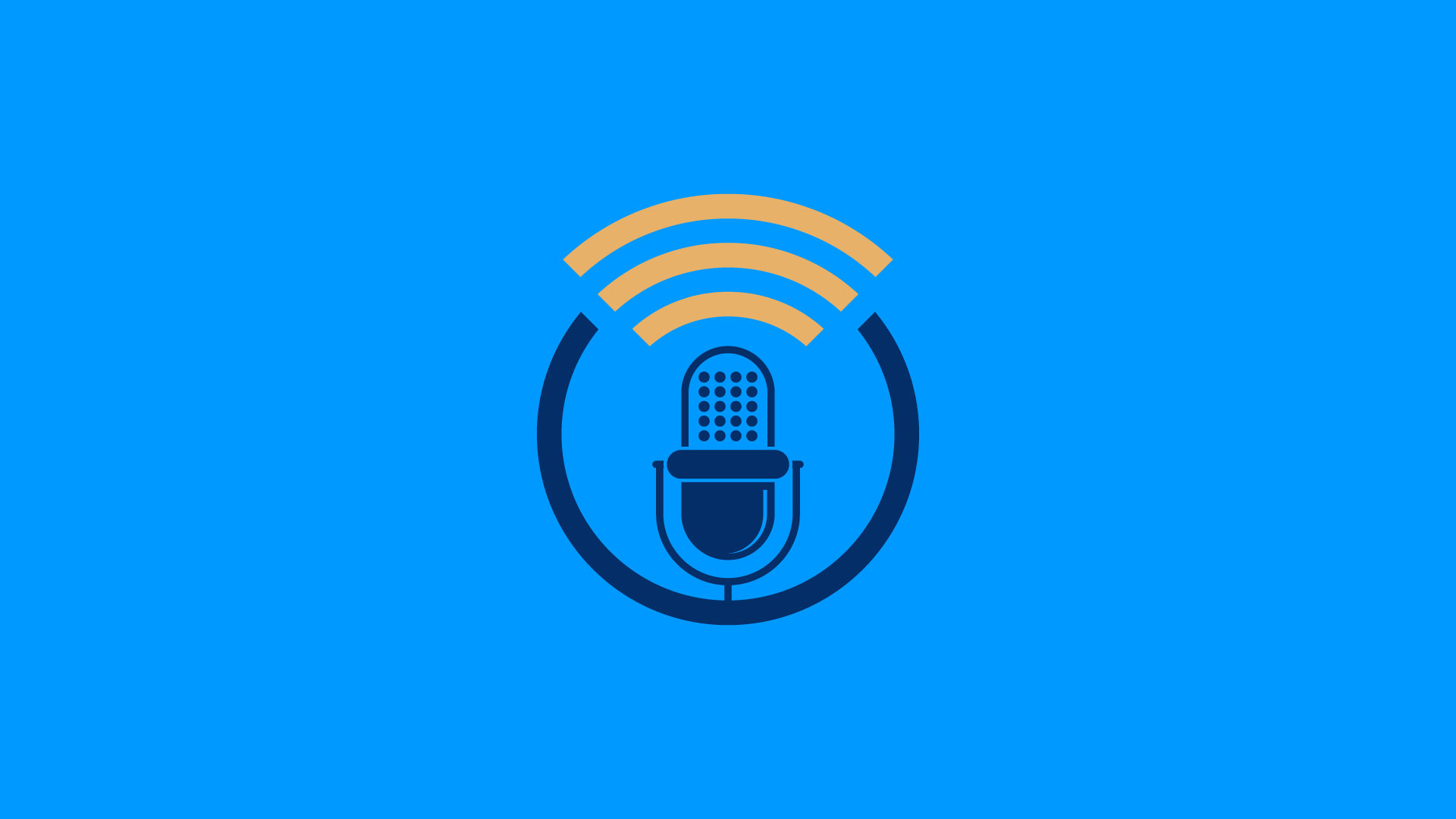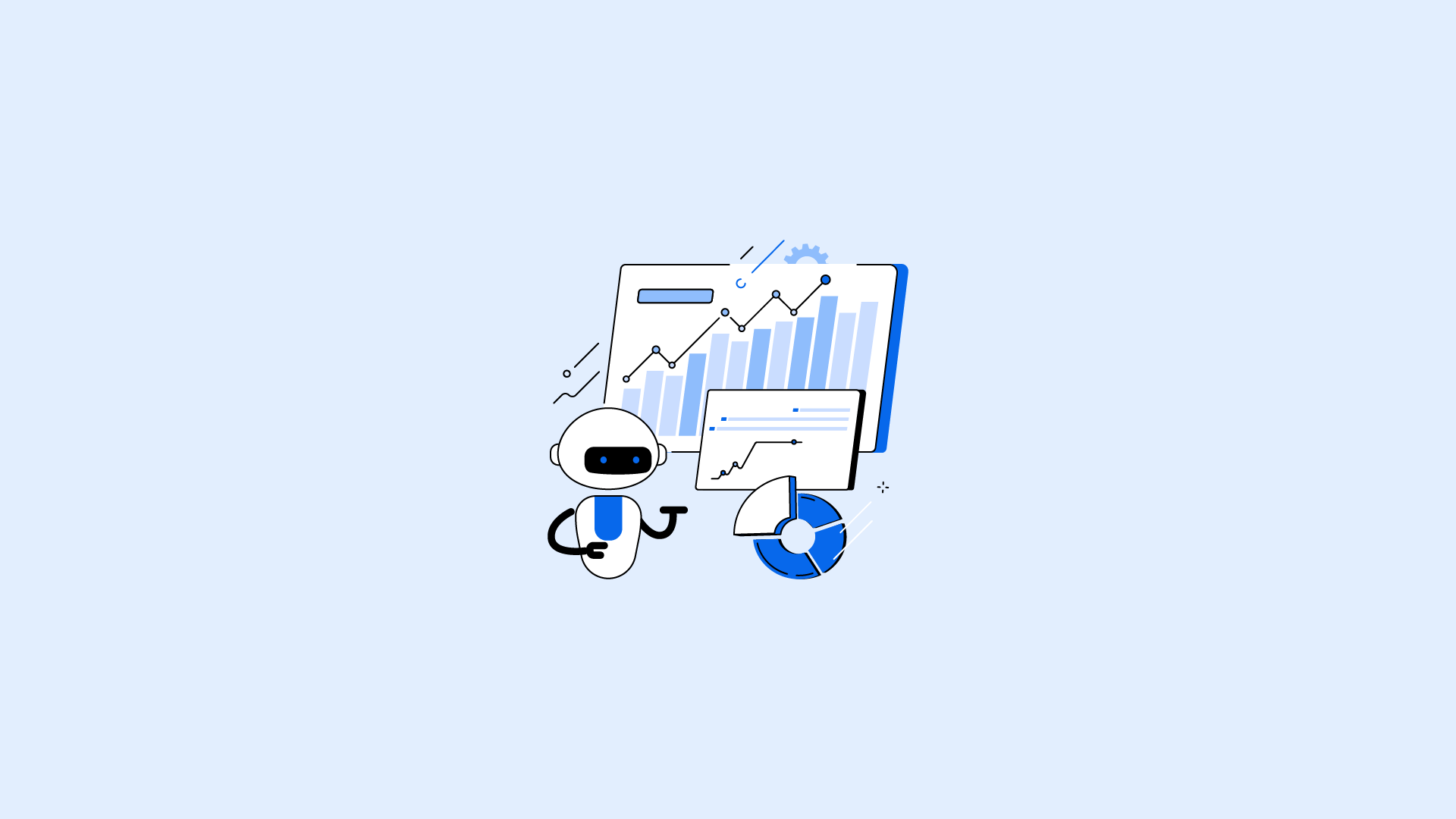Have you ever thought about starting a blog? If yes, then why haven’t you done it yet? Is it because you don’t know where to start or maybe you don’t even know what blogging is? Well, I’m going to tell you exactly what blogging is and how you can get started with blog hosting.
Selecting a reliable blog hosting provider is crucial as it ensures your blog remains accessible to readers with good security and uptime.
Blogging can be a great business idea. Blogging is a good way to share your thoughts and ideas with the world. In fact, according to Hubspot, over half of B2B marketers plan to increase their blogging activities in 2022.
A blog is a website that allows you to write articles. The main goal of a blog is to provide valuable information to its readers. A blog can be a news website.
In this article, we will look at what a blog is and how you can get started with your blog to make money online.
What is a Blog?
A blog (or weblog) is an online journal in which entries are posted regularly, usually daily, to get your blog online and share your thoughts with the world. They may be personal reflections, diary-like, news items, reviews, or any combination thereof.
Why you should Start Blogging
There are many reasons to blog, but here are the top 9

One of the best reasons to start a blog is to establish yourself as an authority on a topic. When you blog regularly, you show that you know what you’re talking about and that people should listen to your advice. This helps in shaping the entire blog around a specific niche, ensuring long-term content planning and sustained interest.
By blogging regularly, you can establish yourself as someone who knows more than others on a certain topic. When people start thinking of you as an expert, they’ll be more likely to trust you and want to work with you.
This is one of the best ways to make money from your blog, and it’s not just about the money. When people trust you and see you as an authority in their industry, it’s easy for them to recommend your products and services.
This is because they know that the people they refer will get great value from the content you produce.
1. Is Blogging Still Relevant in 2024?
Blogging is still a relevant and effective way to share your thoughts, ideas, and expertise with the world in 2024. Despite the rise of social media and other online platforms, blogging remains a popular and powerful tool for building your brand, establishing yourself as an authority in your field, and connecting with your audience.
In fact, blogging is more important than ever in today’s digital landscape. With the increasing noise and competition on social media, a blog provides a unique opportunity to stand out and showcase your personality, skills, and expertise. Unlike social media posts that can quickly get lost in the feed, blog posts have a longer lifespan and can continue to attract readers long after they are published.
Moreover, blogging is a great way to improve your website’s search engine optimization (SEO) and rank higher in search engine results pages (SERPs). Search engines love fresh, high-quality content, and a blog provides a platform to regularly publish new and relevant content that is relevant to your target audience. By consistently updating your blog with valuable information, you can drive more organic traffic to your site and increase your visibility in search engines.
2. It helps you get more Traffic
There’s absolutely no doubt about it. Blogging helps you get more traffic to your website. The No. 1 source of traffic for high-income bloggers is organic traffic from Google.
You can use blogging as a way to let people know you have a website, and then once they’re on your website, they can see what other things you have to offer.
With blogging, you need to one get traffic to your site, and two convert that traffic into paying customers. If you don’t have traffic, people won’t know about your website.
Even if you have an amazing product or service, no one will see it unless they visit your site. If people don’t know about your website, then nothing else matters (yet).
And if you can’t convert that traffic into paying customers, then all the traffic in the world doesn’t matter either.
3. It helps you get More Customers and Clients
Blogging helps you attract more potential customers to your business because of the increased traffic to your website.
It also helps you connect with people who may not have been looking for your brand in the first place. Sometimes people find something interesting in one of your blog posts. And the relationship builds from there.
4. It gives you the ability to connect with other People
One of the best things about blogging is that it gives you a chance to connect with other people who share similar interests as you do.
You may even be able to connect with some very influential people in your field, as well as people who are interested in what you have to offer.
5. You can build a brand that people will recognize
Blogging is the platform that gives you the freedom to explore your creativity and share your passions, thoughts, and ideas with the world.
Blogging allows you to expand your reach, be seen as an expert, and build a brand that people recognize. With blogging, you have the flexibility and freedom to do what you want when you want.
6. It gives you the Ability to Make Money Online
Creating a blog is one of the best ways to start making money online. A lot of people think that blogs are used only by hobbyists. But, if you’re looking for a way to make money online, it’s worth your time to learn how to create and maintain a blog. Selecting reliable web hosting companies is crucial for ensuring your blog’s visibility and accessibility.
There are many ways you can make money through blogging, but the easiest way is by using Google AdSense. AdSense enables you to receive a percentage of the income when someone clicks on an ad on your blog.
You place an ad code on your site and when someone clicks on one of these ads, you earn money.
Thousands of advertisers promote their products or services through AdSense. This means that as long as you have people visiting your blog, you’ll be able to generate some income.
7. You’ll build your online portfolio and brand
The internet is always going to be around. You will have a chance to showcase your skills, knowledge, creations, and ideas on the internet forever.
If you want to build an audience in any niche or make money with your blog then this is a place where you can learn everything you need to know about blogging. This way you can build your online portfolio and grow your passive income.
8. You’ll develop better writing skills
If you’re an aspiring writer or want to be better at anything that requires writing, blogging is the way to go. Everything from emails to text messages requires some form of writing.
Even the way we communicate on social media sites like Twitter requires very short but clear and concise messages. If you want to be a better writer then writing often is the best way to improve your skills.
9. You’ll learn how to create content that gets results
If you’ve ever tried guest posting on other blogs or websites then you know what I mean by having content that gets results. You may have also
Blogging Statistics
Blogging is a content marketing strategy that is scalable and affordable. It is also the third most common content marketing strategy utilized by businesses. Marketers who prioritize blogging see 13 times the ROI of those who don’t according to HubSpot.
Here are some blogging facts you should look at in 2022:
There are over 600 million active blogs globally in 2022, this is out of over 1.9billion websites in the world (Growth Badger)
To top it off about 2 billion blog posts are published every year across the world.
A great storyteller removes 99% of what really happens—the absorptive details—and leaves the interesting 1% for the reader. (com)
When blogging with WordPress you have 100% ownership of your content, files, data, and design—and everything can be backed up. (com)
What are the most Popular Types of Blogs
Blogs are a great way for businesses to connect with their audience and build brand loyalty.
Blogs don’t just give you a chance to share your expertise and establish trust. They offer you the opportunity to show off your personality in a way that’s harder to do with a standard website.
You may be wondering if there are different types of blogs. Yes, there are. I’ve listed the most common ones below:
Personal blogs
Business/corporate blogs
Personal brand/professional blogs
Fashion blogs
Lifestyle blogs
Travel blogs
Food blogs
Affiliate/review blogs
Multimedia blogs
News blogs
Personal Blogs
These are blogs that focus on one particular person and their life experiences. These are the most common type of blogs and would include the majority of blogs you would read. Examples would be a wedding blog, food blog, photography blog, or fashion blog.
These blogs are easy to start and maintain. They don’t need a lot of technical knowledge, just a passion for the subject.
Business/Corporate Blogs
This is a blog that represents a business or corporation. This type of blogging is less common and usually requires more than one author. For example, the Microsoft Blog is written by employees across many different divisions at Microsoft.
These types of blogs may have started as personal blogs but over time they have become more professional as they have grown in popularity.
Personal Brand/Professional Blogs
These are blogs that are used to build the author as an authority or expert in their industry. Personal brand or professional blogs are similar to business/corporate blogs but instead of representing a company, they represent an individual.
The aim is to attract an audience and generate leads for the individual or his/her brand. The blog owner is often featured as the main writer but may have additional contributors as well.
Fashion Blogs
These blogs focus on fashion and trends. Fashion blogs are extremely popular, especially among younger demographics.
A fashion blogger is typically a fashion designer, retailer, model, or even just a fashion enthusiast with great taste in clothing. He/ she writes about style and fashion trends regularly to attract readers who also have an interest in fashion.
Some fashion bloggers make money by selling ad space on their blogs while others make money through affiliate marketing. (i.e. linking to online retailers of products they feature). Some even get paid to attend fashion events and write about them later on their blog.
These types of blogs are dedicated to fashion trends and tips on how to style certain items or create new looks using old pieces. Some fashion bloggers even make money through affiliate sales or sponsored posts.
Lifestyle Blogs
These cover a wide range of topics to do with living your life and include things like food, family, home, health, and well-being, travel, and leisure.
Lifestyle blogging is writing about topics that interest you and tie into your life in some way, such as fashion, beauty, or interior design. The point is to create a community of readers that share your interests, so they regularly visit your site to read what you have to say.
These blogs tend to be very personal because they’re often written by people in their voice, without much attention to style or grammar.
The reason they’re so popular is that they’re easy to start and people love to read them. If you have an interesting life or you could help other people live more interesting lives, this is a great place to start.
Travel Blogs
These blogs are about traveling or exploring new places and can include tips for travelers (What to pack, where to go, where to stay etc).
Travel bloggers write about their adventures and experiences around the world. They often feature photos and detailed descriptions of the places they visited. Also advice for tourists who might want to visit those places themselves.
Many travel bloggers also document their experiences on video and post videos on YouTube. There are even bloggers who make a living by traveling from place to place and blogging about it.
Food Blogs
Food bloggers write about recipes, food trends, and restaurants. They often use descriptive commentary and stunning food photos, preparations, and dining environments. Some food bloggers also provide reviews of eateries based on their experience eating there.
Food is another subject that people love to read about – and talk about! The culture around food is huge, with all sorts of social events being based around eating food together.
Food blogs can be as simple as recipes or they can go into the deeper cultural aspects surrounding food. A good example of a food blog at its simplest is 101cookbooks. an example of a blog that focuses on the deeper aspects surrounding food is The Splendid Table
Affiliate/Review Blogs
These make money through affiliate marketing, which means providing a link to products or services within their blogs with the potential to earn commissions when people click those links and make purchases.
These blogs review or promote products, services, or companies in exchange for payment. Reviewing items on an affiliate blog is often done through an affiliate link, which means the blogger gets paid if someone clicks on that link and buys something.
These blogs write about products to earn commissions from affiliate programs like Amazon Associates or SkimLinks. Review blogs may review a single product or product category, and they may or may not be affiliated with the reviewed products.
Multimedia Blogs
These blogs use varied types of media, such as video clips, music files, animated GIFs, and photographs, instead of or in addition to text. Their content tends to be more entertaining than informational.
Some bloggers prefer to share information in audio or video formats rather than text alone. These types of blogs are known as “multimedia” blogs, and they may include short clips, long videos, podcasts, or even images with commentary attached. (known as photoblogs).
Multimedia Blogs
These blogs use varied types of media, such as video clips, music files, animated GIFs, and photographs, instead of or in addition to text. Their content tends to be more entertaining than informational.
Some bloggers prefer to share information in audio or video formats rather than text alone. These types of blogs are known as “multimedia” blogs, and they may include short clips, long videos, podcasts, or even images with commentary attached. (known as photoblogs).
News Blogs
These blogs focus on current events or breaking news. They often contain links to news websites as well as original commentary by the
These blogs cover news-related items, such as current events, politics, business, and technology. Bloggers who provide commentary on news items are often referred to as citizen journalists.
Many news websites publish current events via a blog format, including The Washington Post’s website and The New York Times’ website.
These are written by one or more authors and are usually intended for a specific audience, e.g., friends and family members or fellow hobbyists.
How to Start a Blog in 13 Steps
Creating a blog is a great way to share your ideas and expertise online. And it can be a key element in the mix of digital marketing tactics you use for your business.
Here’s a ten-step plan for starting a successful blog that will help you attract readers and build your business.
Step 6: Customize Your Blog
Once your blog is set up, you can start customizing it to fit your brand. With just a few clicks, you can create blog menus, change themes, and add widgets to enhance the user experience.
Step 9: Write Your First Blog Post
Now it’s time to write your first blog post. Selecting a topic for your first blog post is crucial; make sure it is relevant to your audience and optimized for SEO. This will help you attract more readers from search engines.
Step 10: Set Up Permalinks
Permalinks are the URLs for your blog posts. It’s important to set a default, SEO-friendly URL structure for new blog posts that incorporates the titles. This can improve your rankings in search engines like Google.
1. Identify Your Blog’s Niche
You can’t just start a blog and expect people to flock to it with no subject matter. You need to decide on your blog niche, or what you will talk about. This will not only help you identify the content you will write but, also your target audience.
There are plenty of topics to choose from however, it is important to write about something you have a passion for. Secondly, even though you may not be an expert at it, you will need to have some basic knowledge to provide your audience with value.
You may be a big fan of football, or soccer in the US, an idea for a blog may be focused on a team in the premier league. When you come up with ideas to write for your blog, you will talk about the premier league concerning the team you have chosen.
For example, if the team you are passionate about is Manchester United, your content will cover the events happening at Manchester united daily. An example of such a blog is The United Stand which shared information about the latest football news.
2. Research your Blog’s Target Audience
Before you can start a blog, you need to understand the topic or niche you’d like to focus on. You don’t have to be an expert in the field, but it helps if you have some background knowledge that you can draw from.
Once you’ve chosen a niche, it’s time to identify your blog’s target audience. Your target audience is the demographic of people most likely to be interested in your blog topics. Here are some questions to ask yourself as you define your target audience:
What age range is your target audience?
What are their interests and passions?
Where do they live?
What problems do they need to solve?
What social media platforms do they use most often?
How much disposable income do they have?
Knowing who you’re writing for will help inform all of your content creation decisions, from topic ideas to how much detail you provide within each piece. You’ll also want to know this information when it comes time to market and monetize your blog.
All this will help you gather your thoughts on why you are blogging. It will keep you going when things get thought and you need the motivation to keep going.
3. Name your Blog
Naming your blog is an important step and not to be overlooked. Whether you’re doing a personal blog or starting a business, the name you choose will help brand your blog and make it more memorable.
If your blog takes off, you’ll want your blog name to be something that is timeless and you would have to change in the future.
Your blog name can be keyword-based or brand-based, this will most likely be influenced by your niche. You can name your blog after a particular brand or an industry or something personal with a high search volume.
There are also tools available to help you with generating blog names online. Here is a blog name generator you can try.
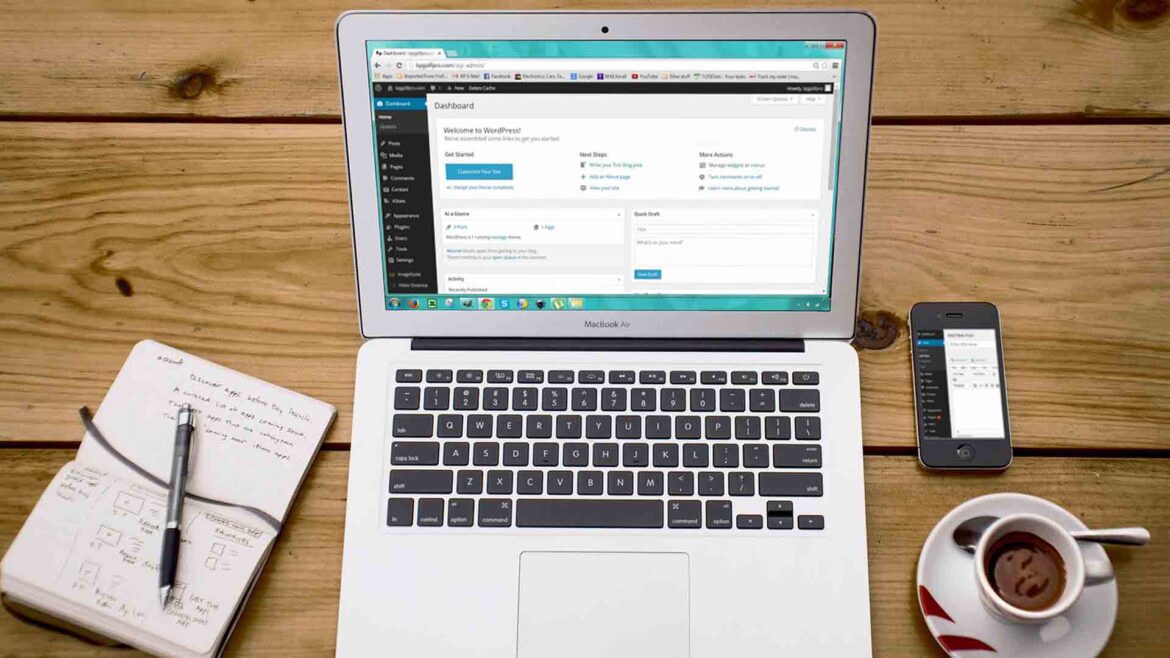
4. Find a Blogging Platform (CMS)
A content management system is a platform you can use to design, manage and publish your blog. There are both free and paid options, but I am going to assume you will need a paid option because you are starting your blog to make money online.
A paid platform will ensure your content is safe and your audience or businesses who may want to partner with you can trust you. Using free blogging platforms can make you look cheap and unprofessional.
The two main platforms we recommend for blogging are WordPress and the HubSpot CMS. WordPress will need a WordPress hosting service, like Dreamhost, Bluehost, or Hostinger.
WordPress is the most popular CMS in the world, powering more than 30% of websites globally. And, it is the cheapest and easiest of the two to get started with. An example of a blog hosted on WordPress is ours. And, because we use Dreamhost I will show you how you set yours up on Dreamhost, including how to select and install a suitable blog theme.
5. Buy a Web Hosting package and a Domain
When choosing how you are hosting your blog, you can consider your budget, and hosting features you need. Blog hosting is a crucial first step in starting a blog. There is an option of using a hosting service or hosting on your own server. If you are choosing a professional web hosting service, there are several options to choose from for your WordPress blog. I consider DreamHost the best option to get started.
Checkout this Dreamhost review
To get started, consider these three web hosting options;
DreamHost’s Shared hosting is the cheapest option but can be limiting in terms of performance. It is best suited for new sites with low traffic and should not be used for high traffic sites. Prices start from $2.59/month and are the best place to start.
Managed WordPress hosting allows you to focus on building and growing your blog without worrying about the technical part of web hosting.
Virtual private server (VPS) hosting is a more powerful hosting plan with dedicated resources and is best for blogs growing in traffic.
Dedicated hosting is a more expensive web hosting option. With dedicated hosting, you get an entire server dedicated to your website alone.
You will also decide whether you want a hosting service that’s managed or not. With a managed hosting plan, your hosting service provider manages the technical side of your hosting environment.
Once you have decided on your hosting plan you will need a domain name. Your domain name will usually be the name of your blog with a domain extension.
How to purchase a shared hosting plan on Dreamhost
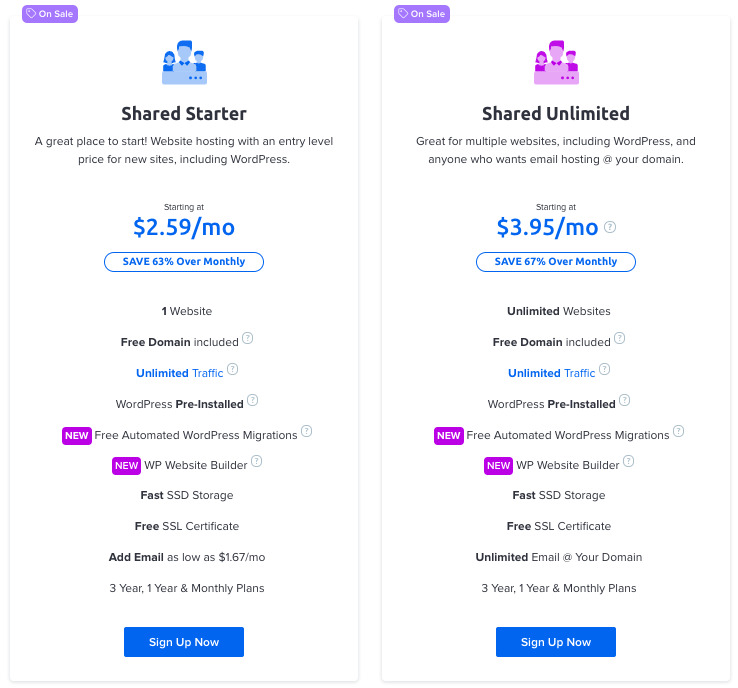
If you’d like to purchase a shared hosting plan, just go to the DreamHost Shared Plans page and select Sign up Now. You’ll then have to choose your billing term: monthly, annually, or every three years. You get a bigger discount on hosting with a longer hosting plan.
You’ll also be able to select from DreamHost’s Starter Shared and Shared Unlimited packages. The Starter plan is the most cost-effective option, although you won’t get a professional email address to go with your domain.
For just $1.67 more each month, you can get an email address to go with your website domain. The shared unlimited plan will give you everything you need to succeed online.
The next step is to register a domain, which comes free with annual plans. The other option is to attach a domain you already own.
Assuming that you are buying a new domain, click on “Register a new domain” and add in your proposed domain name. Dreamhost will give you a list of the available domain names in different TLDs for you to choose from.

The next step is to enter your billing information and review your order. When you are here make you check the Pre-Install WordPress box to set your site up quickly.
Additionally, you can add DreamShield malware protection for an extra $3/month.
After selecting the types of hosting and domains you want, choose how you want to pay for them by filling in your credit card information. Once you click Submit Order at the bottom of the screen, we’ll create your account. DreamHost accepts all major credit cards and PayPal.
When you are done purchasing your hosting plan and installing WordPress, make sure to add a nice WordPress theme to go along with your blog.
6. Customize your Blog
After choosing a theme for your blog, you should customize your blog’s appearance with widgets and other options available in your WordPress dashboard.
For example, if you plan on having social media buttons on your blog to help promote it, there are plugins available that allow you to add those buttons automatically to each post and page on your blog.
Some widgets allow you to add a sidebar with navigation linking to other pages on your site or even a newsletter signup form for visitors to subscribe to receive updates from you by email.
7. Create a Blogging Strategy
Once your blog is set up, the only thing you need to start drawing readers in and keeping them coming back is the content. The design and layout are fun, of course, but they’re necessary functionally.
Creating a blog strategy and editorial calendar is a great way to stay organized, keep your content fresh, and reach your readers.
Creating an editorial calendar will help you determine what exactly you’re going to write about on your blog when you’re going to publish each post, and how often you’ll be sharing new content.
Come up with a weekly posting schedule and stick to it. If your readers know exactly what days they can expect new content from you, they’ll be more likely to visit your site often.
Create an editorial calendar for your blog posts by listing topics you want to write about and when you plan to publish them.
This will help you stay on schedule and focused on writing topics that have the most appeal to your audience at the time you want to publish them.
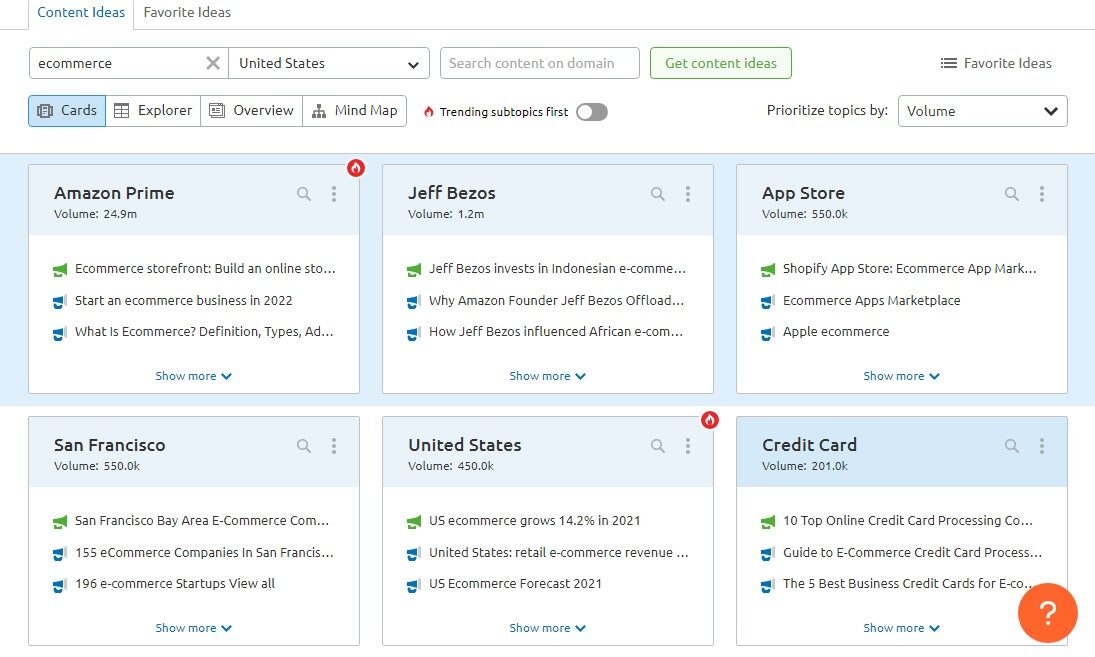
8. Brainstorm Content Ideas based on your target audience
Now that you’ve identified who your target audience is, it’s time to come up with content ideas that will appeal to them.
Once you start blogging you will want to create high-quality content your audience will relate to. Also, content that will solve your audience’s problems.
The best place to find content ideas is finding what your target audience searches for to find the answers they are looking for. To start brainstorming ideas, consider these tools;
Google Keyword Planner,
SEMrush,
Google trends,
Answer the Public, and
SE Ranking.
Ubbersuggest
Always try and find related topics and the questions people are asking on the People also ask a section of google. Also, you should be frequently looking for content ideas so they stay fresh at all times.
Another way to come up with new blog topics is to use Google Alerts. Simply type in some keywords related to your niche and set up alerts for any time they appear in the news.
This can help you stay on top of things and give you plenty of material to write about. You can also use these alerts as inspiration for creating new content such as videos or infographics that are related to the news stories from Google Alerts.
You can also use sites like Twitter and Facebook to find out what people are saying about topics that interest them. Then, write about those topics on your blog.

9. Write your First Blog Post
You may be wondering, “How do I get started?” and “What do I write?”
Well, these are great questions and there are many ways to go about answering them. One of the most important parts of writing blog posts (and writing in general) is to find your voice. If you’re new to this, that may sound a little confusing.
Think about it like this: When you read a newspaper, you can probably tell when an article is written by the same author even if it’s been years since you’ve read any of their work. That’s because each writer has a unique style, even if they write on a variety of topics.
Finding your style as a writer takes time and practice. That being said, it’s also something that many people (myself included) struggle with. The good news is that once you get going, blogging offers ample opportunities to practice your craft.
Customization is not only about your writing style, but it includes, customizing the look of your blog.
One way to do this is by adding a logo on your blog. Also, add an about page to tell your audience who you are and what your blog is about.
10. Optimize your blog for Search Engine Optimization
When you create a website, SEO (search engine optimization) should be at the top of your list of priorities. Why? Because organic search is one of the leading drivers of traffic to websites.
If you’re not familiar with SEO, it’s essentially the process of creating content that search engines can easily find and rank as relevant. The more relevant your site is to search results, the better chance you have of gaining a high-ranking position.
A good SEO strategy will help you attract visitors who are likely to convert into leads or customers. For example, if someone searches for “toy poodle breeders in Tampa,” Google will show the results based on the keywords they entered.
If your website includes those same keywords and is optimized effectively, then there’s a good chance it will appear in search results — but only if you’ve done a good job optimizing for SEO.
The more you optimize your blog posts for SEO, the easier it will be for users to find them. And if you’re targeting popular keywords, your blog posts might even appear at the top of search engine results pages (SERPs). This can help drive traffic to your site and increase your audience.
Keyword Optimization
Here’s an example of a keyword phrase that is very common in the blogging world: “how to start a blog.” This is a broad topic with lots of competition, so you’ll need to do an extensive amount of research if you want to optimize your blog for this keyword.
Let’s say you’ve done all of your research, and you’ve determined that this is the keyword phrase you want to rank for. Now it’s time to incorporate that phrase into your blog post. Here are some ways you might do this:
Include the keyword phrase in your post’s title
Include the keyword phrase in headings or subheadings throughout your blog post
Add the keyword phrase in the URL of your blog post
Include the keyword phrase in bold text or italics throughout your blog post
Also add variations of the keyword phrase (e.g., “what is a blog?”) in your blog post
Clearly defining Heading tags
Headings provide a clear hierarchy to your blog post and help break up long pieces of content so they’re easier to read. They also give an overview of the main ideas in a post and make it easy for readers to scan a page and find information that interests them.
Additionally, headings give search engines more context about the content on your page. This is important because it tells search engines which parts of a post are most important and how they relate to each other.
It’s important to remember, however, that Google has a lot of rules when it comes to optimizing your website. In fact, Google even has an entire search quality team dedicated to identifying websites and tactics that don’t follow their guidelines.
To avoid Google penalties, be sure to avoid:
Spamming keywords on your blog posts. This includes over-optimizing your content with too many keywords, using hidden text or hiding links on your site, stuffing content with irrelevant keywords, and more.
Cloaking or redirecting users based on their location or IP address.
Creating pages with little to no original content.
Copying content from other sources without adding any original value or insight.
Spamming blog comments to promote your blog posts.
Creating pages with malicious behavior such as phishing scams, viruses, or malware attacks.
11. Create a Verbal Style Guide for your Blog
A style guide is an essential tool for bloggers. A style guide is a set of guidelines that determines how your blog posts should be written and formatted.
This makes your blog appear more professional and authoritative. A style guide can help your content have a consistent tone.
If you’re a blogger, it can be helpful to develop a style guide for your blog. Other people who contribute to the blog can use this guide to ensure that they follow your guidelines, ensuring that all posts on the blog feel cohesive (regardless of who wrote them).
There are several things to consider when creating a verbal style guide for your blog.
To create a style guide consider your voice and tone, do you want to sound funny, or serious. What language are you using to write your blog? Finally, consider punctuation and formatting.
As your blog grows, your visual style guide will evolve.
While it is natural to feel like you can relax once you’ve published a few posts and sailing with writing content, this would be a mistake. All your hard work thus far could effectively be for nothing if no one knows that your blog even exists.
The importance of sharing your blog and creating a brand around it may seem obvious to you, but even experienced bloggers can sometimes forget.
It’s such an important part of your marketing strategy that I want to review the steps you can take to spread the word about your blog and keep it top-of-mind for your audience.
12. Promoting Your Blog on Social Media
Promoting your blog on social media is a great way to increase your online visibility, drive traffic to your website, and build your brand. Here are some tips to help you promote your blog on social media:
Share Your Blog Posts: Make sure to share your blog posts on all your social media profiles, including Facebook, Twitter, Instagram, and LinkedIn. This will help you reach a wider audience and drive more traffic to your blog.
Use Relevant Hashtags: Hashtags can make your content more discoverable. Use relevant hashtags related to your blog post topics to reach people who are interested in those subjects.
Engage with Your Audience: Respond to comments and messages from your followers. Engaging with your audience helps build a community around your blog and encourages more people to visit your site.
Share Behind-the-Scenes Content: Give your audience a glimpse into your creative process by sharing behind-the-scenes photos or videos. This can make your followers feel more connected to you and your blog.
Collaborate with Other Bloggers or Influencers: Partnering with other bloggers or influencers in your niche can help you reach a larger audience. Collaborations can include guest posts, joint social media campaigns, or shoutouts.
Use Paid Social Media Advertising: If you want to reach an even larger audience, consider using paid social media advertising. Platforms like Facebook and Instagram offer targeted advertising options that can help you drive more traffic to your blog.
13. Make Money with your Blog
There are several ways to make money with your blog. When you consider monetizing your blog, there are many options you can choose from or even combine.
You can use your blog to join affiliate marketing programs, where you will promote products for different brands and get a commission for your sales. This is one of the fastest ways to monetize your blog content.
The second option is to sell products. You can sell courses related to your content or sell an eBook.
There is an option of asking your readers to donate for you to continue producing content they fund valuable, this way you can avoid selling to them.
Finally, if your traffic has grown enough Google AdSense can help you implement banner advertising on your website. Ads are automatically generated to suit your blog and your only focus will be to produce content and drive traffic to your site.
Choosing a Blogging Platform
Choosing the right blogging platform is a crucial step in starting a successful blog. With so many options available, it can be overwhelming to decide which platform is best for you. Here are some factors to consider when choosing a blogging platform:
Ease of Use: Look for a platform that is easy to use and navigate, even if you have no prior experience with blogging. A user-friendly interface will make it easier for you to focus on creating content rather than dealing with technical issues.
Customization Options: Consider a platform that offers a range of customization options, such as themes, plugins, and widgets, to help you create a unique and personalized blog. The ability to customize your blog’s appearance and functionality can help you stand out and provide a better user experience.
SEO Features: Choose a platform that is optimized for search engines, with features such as meta tags, titles, and descriptions. Good SEO features will help your blog rank higher in search engine results and attract more organic traffic.
Integration: Consider a platform that integrates with other tools and services, such as social media, email marketing, and e-commerce platforms. Integration with these tools can help you streamline your workflow and expand your blog’s capabilities.
Support: Look for a platform that offers reliable customer support, including tutorials, documentation, and community forums. Good support can help you resolve any issues quickly and keep your blog running smoothly.
What is a Blogging Platform?
A blogging platform is a software or service that allows you to create and manage a blog. It provides a range of features and tools to help you design, publish, and promote your blog, including templates, themes, plugins, and widgets. A good blogging platform will make it easy for you to create content, customize your blog’s appearance, and engage with your audience.
Popular Blogging Platforms (WordPress, Blogger, Wix)
There are many popular blogging platforms available, each with its own strengths and weaknesses. Here are some of the most popular options:
WordPress: A self-hosted platform that offers a range of customization options, plugins, and themes. WordPress is highly flexible and can be used to create any type of blog, from personal blogs to business websites. It also has a large community of users and developers, which means you can find plenty of resources and support.
Blogger: A free platform that is easy to use and integrates with other Google services. Blogger is a good option for beginners who want to start a blog without any upfront costs. However, it has fewer customization options compared to WordPress.
Wix: A website builder that also offers a range of blogging features and templates. Wix is known for its drag-and-drop interface, which makes it easy to design a blog without any coding knowledge. It also offers a variety of templates and apps to enhance your blog’s functionality.
How to Choose the Right Platform for Your Own Blog
Choosing the right blogging platform for your own blog depends on your needs and goals. Here are some factors to consider:
Your Level of Technical Expertise: If you have no prior experience with blogging, consider a platform that is easy to use and navigate. Platforms like Wix and Blogger are user-friendly and require little to no technical knowledge.
Your Budget: If you are on a tight budget, consider a free or low-cost platform. Blogger is a free option, while WordPress offers affordable hosting plans.
Your Customization Needs: If you want a high degree of customization, consider a self-hosted platform like WordPress. WordPress offers a wide range of themes, plugins, and customization options to help you create a unique blog.
Your Integration Needs: If you need to integrate your blog with other tools and services, consider a platform that offers a range of integrations. WordPress, for example, integrates with many social media, email marketing, and e-commerce platforms.
By carefully considering these factors, you can choose the right blogging platform that meets your needs and helps you create a successful blog.
Blog Writing Tips
Keep it short and readable.
Blogs should be easy to read and follow. A good rule of thumb is to keep paragraphs between 3-and 5 lines long and sentences shorter than 20 words. If you’re writing a longer post, try breaking up the content with subheadings or bullet points.
Use bold, italics, and underline sparingly.
These formatting tools are great for drawing attention to important words and phrases, but too much can make your readers’ eyes glaze over. Bolding one or two words per paragraph should be fine – just use them wisely!
Create hyperlinks for relevant terms and phrases.
Linking to other sites helps your readers find more information on a topic, which will keep them engaged with your content longer. Plus, linking out is a great way to build relationships with other bloggers!
Double-check spelling and grammar before publishing new posts.
This may seem obvious, but you must proofread each post before publication to ensure accuracy and readability for your audience.
In Summary: How to Start a Blog
If you have something to say, don’t be afraid to go out there and say it. Blogging can be fun, even if no one ever reads your work!
While blogger’s platforms are great for helping people find your blog and add it to their favorite sites, it’s important to first set up a good foundation before you begin your blogging journey.
Choose a niche and content type that will interest you and the audience that you want to attract. This is important because the more interested you are in the subject at hand, the more likely you are to continue writing about it.
To sum up, beginning a blog is easier than you might think. The hardest part is coming up with topics to write about and consistently publishing new content. Anyone can do it, though.
You just have to be passionate and willing to put yourself out there on the Internet in your little corner of the world. And even if nobody reads your blog, if you’re able to post something every day then you will at least achieve consistency—and that will be enough for you.
If you’re an entrepreneur, a freelancer or just someone who is looking for a creative outlet, starting a blog can be a fun and rewarding way to express yourself and build your brand. Plus, it’s increasingly relevant in today’s world of social media. So check out our post above for some tips and tricks on how to start your blog.
How to Start a Blog FAQs (Frequently Asked Questions by New Bloggers): People Also Ask
1. How can a beginner start blogging?
A beginner can start blogging by choosing a niche they are passionate about, selecting a blogging platform such as WordPress, and setting up a blog with a reliable web hosting service. It’s important to create high-quality content that resonates with the target audience and to optimize the blog for search engines to attract organic traffic.
2. How do bloggers get paid?
Bloggers can earn money through various methods, including affiliate marketing, sponsored posts, selling digital products or services, and displaying ads through programs like Google AdSense. Building a strong audience and consistently producing valuable content are key to monetizing a blog successfully.
3. Can you start a blog with no money?
Yes, it’s possible to start a blog with no money by using free blogging platforms like Blogger or WordPress.com. However, investing in a custom domain and hosting service can provide more control and monetization opportunities.
4. Do blogs still make money?
Yes, blogs can still be profitable if they are well-maintained, optimized for search engines, and provide value to their audience. Successful blogs often focus on specific niches and utilize multiple income streams to generate revenue.
5. What is the best blogging platform for beginners?
WordPress is often recommended for beginners due to its flexibility, ease of use, and extensive range of plugins and themes. It allows bloggers to customize their sites and grow their audience effectively.
6. How to start a blog in 7 steps?
Choose a niche and research your target audience.
Select a blogging platform and set up your blog.
Pick a domain name and register it.
Choose a web hosting service and install your blog.
Customize your blog’s design and layout.
Create a content strategy and write your first blog post.
Promote your blog on social media and optimize for SEO.
7. How To Start A Blog And Make Money In 2024?
To start a blog and make money in 2024, focus on selecting a profitable niche, creating high-quality content, building an audience, and diversifying income streams. Utilize SEO strategies to increase visibility and engage with your audience through social media and email marketing.
8. How to start a blog with the help of Adobe Express?
Adobe Express can assist in creating visually appealing blog graphics and branding elements. Use it to design logos, social media posts, and featured images that align with your blog’s theme and style.
9. What beginner-friendly blog tools can help start a standout blog?
Beginner-friendly tools include Canva for graphic design, Grammarly for writing assistance, Google Analytics for tracking blog performance, and Yoast SEO for optimizing blog posts. These tools help streamline the blogging process and enhance content quality.
10. How to Start Blogging: A Definitive Guide for Authors?
Authors can start blogging by focusing on topics related to their books, writing process, and industry insights. Sharing personal experiences and engaging with readers can help build a loyal audience and promote their work effectively.


